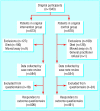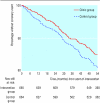Secondary prevention clinics for coronary heart disease: four year follow up of a randomised controlled trial in primary care
- PMID: 12521974
- PMCID: PMC139939
- DOI: 10.1136/bmj.326.7380.84
Secondary prevention clinics for coronary heart disease: four year follow up of a randomised controlled trial in primary care
Abstract
Objectives: To evaluate the effects of nurse led clinics in primary care on secondary prevention, total mortality, and coronary event rates after four years.
Design: Follow up of a randomised controlled trial by postal questionnaires and review of case notes and national datasets.
Setting: Stratified, random sample of 19 general practices in north east Scotland.
Participants: 1343 patients (673 intervention and 670 control) under 80 years with a working diagnosis of coronary heart disease but without terminal illness or dementia and not housebound.
Intervention: Nurse led secondary prevention clinics promoted medical and lifestyle components of secondary prevention and offered regular follow up for one year.
Main outcome measures: Components of secondary prevention (aspirin, blood pressure management, lipid management, healthy diet, exercise, non-smoking), total mortality, and coronary events (non-fatal myocardial infarctions and coronary deaths).
Results: Mean follow up was at 4.7 years. Significant improvements were shown in the intervention group in all components of secondary prevention except smoking at one year, and these were sustained after four years except for exercise. The control group, most of whom attended clinics after the initial year, caught up before final follow up, and differences between groups were no longer significant. At 4.7 years, 100 patients in the intervention group and 128 in the control group had died: cumulative death rates were 14.5% and 18.9%, respectively (P=0.038). 100 coronary events occurred in the intervention group and 125 in the control group: cumulative event rates were 14.2% and 18.2%, respectively (P=0.052). Adjusting for age, sex, general practice, and baseline secondary prevention, proportional hazard ratios were 0.75 for all deaths (95% confidence intervals 0.58 to 0.98; P=0.036) and 0.76 for coronary events (0.58 to 1.00; P=0.049) CONCLUSIONS: Nurse led secondary prevention improved medical and lifestyle components of secondary prevention and this seemed to lead to significantly fewer total deaths and probably fewer coronary events. Secondary prevention clinics should be started sooner rather than later.
Figures
Comment in
-
The benefits of nurse led secondary prevention clinics for coronary heart disease continued after 4 years.Evid Based Nurs. 2003 Oct;6(4):123. doi: 10.1136/ebn.6.4.123. Evid Based Nurs. 2003. PMID: 14577406 No abstract available.
References
-
- Scottish Intercollegiate Guidelines Network. SIGN guideline number 51: management of stable angina—a national clinical guideline. Edinburgh: SIGN; 2001.
-
- Department of Health. National service framework for coronary heart disease. London: DoH; 2000.
-
- EUROASPIRE II Study Group. Lifestyle and risk factor management and use of drug therapies in coronary patients from 15 countries; principal results from EUROASPIRE II Euro Heart Survey Programme. Eur Heart J. 2001;22:554–572. - PubMed
Publication types
MeSH terms
LinkOut - more resources
Full Text Sources



